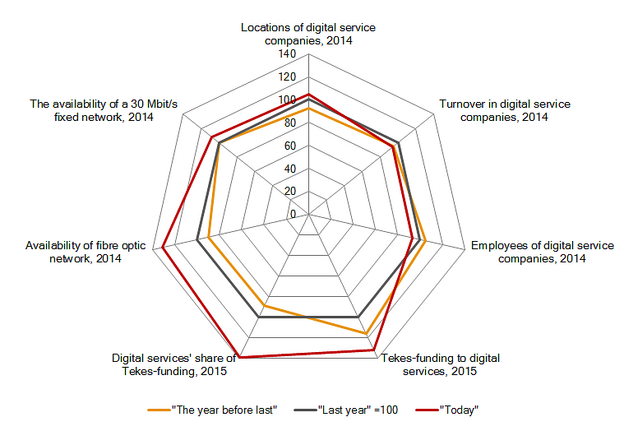The Tampere region has a solid foundation in software and IT, and the importance of digital services in the region has grown over the years. As digitalisation progresses, the region will have increasing business opportunities and new jobs as well as the need for new kinds of expertise and new kinds of talents. The structural change in the ICT industry has released a significant number of internationally experienced employees to seek new opportunities. Indeed, many of the success stories in the Tampere Region in recent years come from the ICT sector.
The turnover in digital service has increased steadily throughout the 2010s, and the number of sector locations and employees has also increased. In 2014, there was a decrease in turnover (-5.9%) and the number of employees has declined after the peak year of 2013 (-6.8%). This drop in the number of employees is attributable to downsizing measures taken by large operators, such as Nokia. However, there was a further increase in the number of locations in 2014 (+4.7%). This suggests that, despite the downsizing of large operators in the sector, new operators are constantly joining the sector. Digital services is, after all, overrepresented among Tampere Region growth companies in proportion to the economic structure. Although the information and communications sector accounts for only 3 per cent of the economic structure, where official growth companies are concerned, their share of the sector rises to 20 per cent. Software developers in particular are found among growth companies (9%). The digital sector is also most common sector of companies operating on a innovation platform basis and startups.
In relation to all sectors, digital services companies are also more successful within their respective sectors. Of the Tampere Region's digital services companies, 6.9 per cent are amongst the most profitable companies in their sector in Finland, whereas 3.0% of the Tampere Region's companies in all sectors are amongst the most profitable companies within their respective sectors in Finland. 7.7 per cent of the digital services companies are amongst the fastest growing companies (3.0% of the companies of all sectors) and 5.7 per cent are amongst the largest companies in their sector (2.7%). **
Digital services are also a major recipient of Tekes funding in the Tampere Region. In 2015, digital services accounted for 14.2 per cent of all funding granted to the Tampere Region. The amount of funding granted increased year-on-year to as much as 31.5 per cent.
High-speed and functional connections are prerequisites for making distance work possible. Functional connections and other digital infrastructure also enhance regional digital capacities and promote the building of digital capabilities. In the Tampere Region, the availability of connections has been constantly developing. In 2015, the Ministry of Transport and Communications reviewed the availability of the 100 Mbit/s fixed network and fibre optic network. The information of this review is not, however, comparable with reviews from previous years. The most recent review indicates that there is still work to be done in developing network availability. The availability of a 30 Mbit/s fixed network and fibre optic network was examined in the situational graph shown here.
ICT sector companies are attractive workplaces in Tampere. The 2016 Great Place to Work survey reveals that Tampere's ICT sector is the best in Finland. Tampere software developer Vincit Oy has won the Best Workplace in Finland title three years running, and in 2016 the company was also chosen as the Best Workplace in Europe. Success is not just limited to employee satisfaction - the company is also growth-oriented, forward-thinking and enjoying exponential turnover growth. It is one of the fastest-growing and most profitable companies in Finland and one of the largest in its sector. **
The City of Tampere is also participating in the 6Cities Open Data spearhead project, which promotes making data openly available, particularly data produced by public administration. Open data is digital raw material, which can also be used in commercial applications, such as the development of digital services. The City of Tampere has thus far opened over 140 datasets and interfaces are constantly being developed. Read more about the Open data spearhead project
Digital development in the region is supported by, for example, AIKO funding. Intended for making the digital leap, this funding may be sought for rapid digitalisation, which promotes the development of, for example, the manufacturing industry or welfare services.
**Source: Vainu, status August 2016

